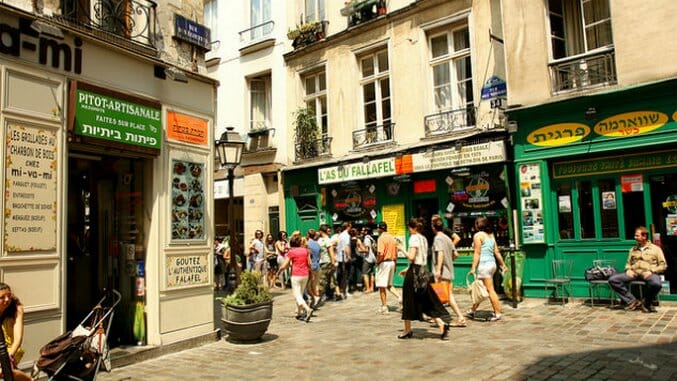
Visitors to Paris will quickly notice something different about the small cobbled rue des Rosiers. Unlike the rest of Paris, where cafés and brasseries dot the sidewalks, here, offerings lean more toward challah, pastrami, and falafel.
The rue des Rosiers has been the epicenter of Jewish life, culture, and food in Paris since the late 19th century, and while the street’s inhabitants and storefronts were once principally Ashkenazi, after World War II and the mass expulsion of the Jewish population from France, things began to change.
The Jewish community in France began to grow, later to become the fourth largest Jewish community in the world in the second half of the century. Paris was welcoming not Eastern European Ashkenazi Jews, but Sephardic Jews from Algeria, Tunisia, and Morocco, who brought their own dishes and culture. According to The Book of Jewish Food, the “discreet and self-effacing” French Ashkenazi Jewish tradition was replaced by “colorful traditional Judaism and ebullient assertiveness” when the Sephardic Jews arrived. Today, France is one of the only places in the world where Sephardim outweigh Ashkenazim, at 80 percent to 20 percent (almost the exact opposite of the American Jewish community), meaning that the traditional rue des Rosiers began to languish.
Until the falafel vendors moved in, that is.
Today, the rue des Rosiers is home to five different falafel shops, each offering a to-go sandwich of pita, fried falafel balls, hummus, tahini, and vegetables, with a dollop of harissa for those who like a bit of spice. But it all started with l’As du Fallafel, and it seems everyone wants to imitate the original.
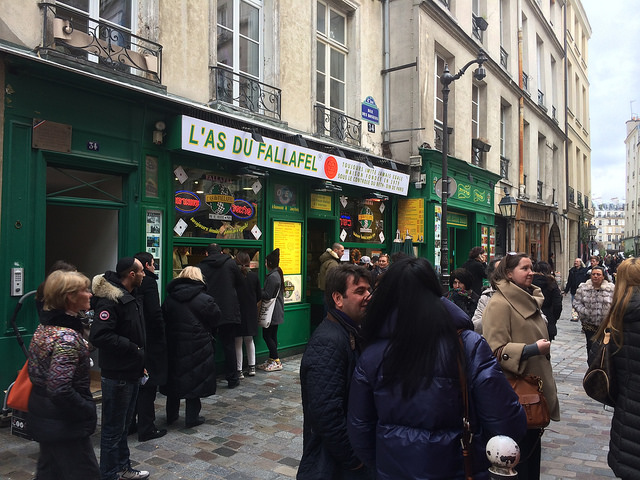
Photo by Randy Breese CC BY
In 1979, the family storefront was opened by the parents of the current manager, Yom-Tov Peretz, and introduced this Israeli specialty to the French Jewish community for the very first time.
“This is really a family business,” Yom-Tov says. “There’s me, my wife, my brother-in-law. My mother passed away two, three years ago, and she was really the symbol of the restaurant.”
At first, the family catered principally to the Jewish community, but soon, they found their customer base growing.
“People come from all over the world to discover our falafel,” Yom-Tov says. “I guess you could say our notoriety has allowed us to become popular, particularly thanks to the artists that come here. Lenny Kravitz was the first.”
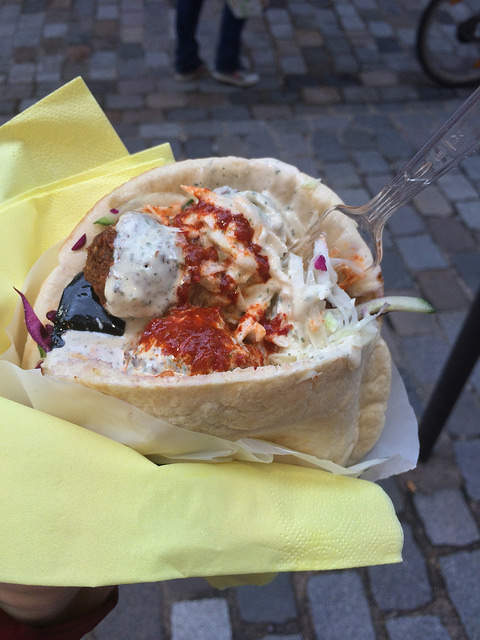
Photo by Randy Breese CC BY
But he wasn’t the last. Vanessa Paradis and Johnny Depp are just two of the famous faces to grace the As du Fallafel, and it wasn’t long before other vendors decided to get in on the action.
Right across the street from l’As is is Mi-Va-Mi, which opened in 1998 and has quickly gained in popularity amongst the locals. “You wait less in line, and the quality is really good for the price,” Caroline, 19 years old, told Le Parisien in August 2015. “I always enjoy it.”
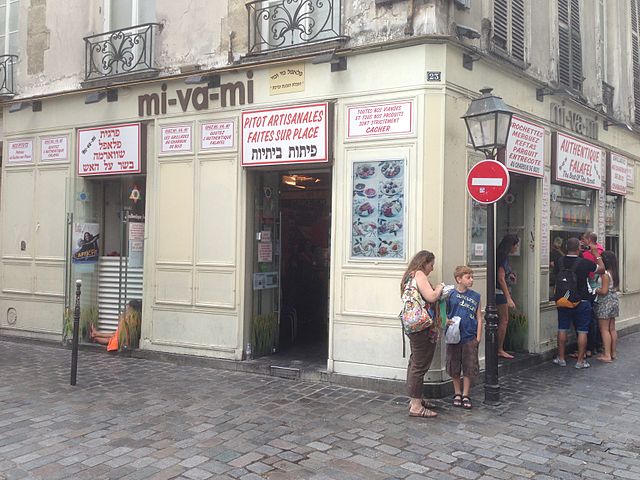
Photo by RG72 CC BY-SA/Wikimedia Commons
While Mi-Va-Mi doesn’t have the stamp of approval of nearly as many famed restaurant critics, it holds its own, to the point where the rivalry between the two shops has become fairly fierce – much more so than with the other three neighbors.
“With the other falafel shops, we get coffee together and stuff, because they’re 20 or 30 meters away, so that’s a pretty reasonable distance,” Yom-Tov says. “Everyone has the right to happiness; everyone has the right to work.”
A waiter at King Falafel Palace agrees, telling the Parisien, “We’re higher up on the street, so we’re a bit further away from the competition.”
With Mi-Va-Mi, however, things aren’t quite so peachy. “When you have a competitor who’s only 2 meters in front of you, who’s trying to steal your clients, who set up 20 years after you, well … you kind of have to defend yourself,” Yom-Tov says. This boils down to a daily yelling match – not at one another, but to tempt potential customers.
Each afternoon, vendors in front of each of the shops call out to passers-by, complimenting tourists, particularly girls, and attempting to convince them them that theirs is the very best on the street. Mi-Va-Mi has even added a sign reading “Taste and Compare” to its front door to draw people away from l’As’ infamous queues.
L’As, meanwhile, tries to speed up the line, which can reach 120 meters on Sunday, the shop’s busiest day, by using walkie-talkies to take orders from clients as they wait.
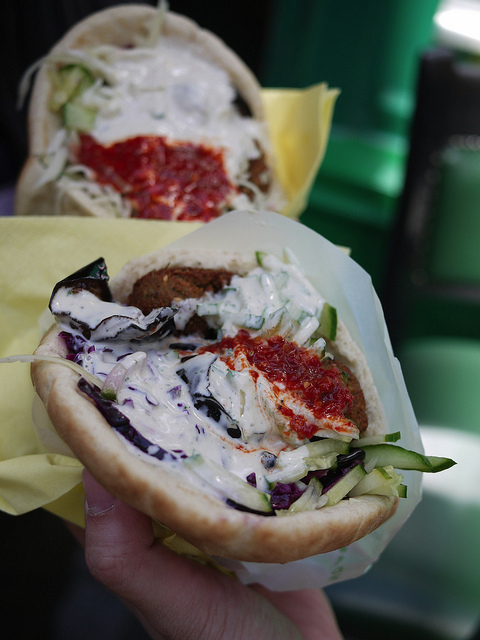
Photo by nienfanhsun CC BY-SA
“We’re efficient,” Yom-Tov says. “We’ve got a team of 7 people preparing the sandwiches, so the line is pretty overwhelming at first, but it goes pretty fast. Every 15 seconds, a sandwich comes out, and on Sunday, we open a second window.”
Sunday is a day when everything else in Paris shuts, except for the Jewish Marais, which has traditionally remained open. L’As, while open on Sundays, is closed on busy Saturdays, when so many tourists are wandering the streets looking for a bite to eat after a day of vintage shopping in the neighborhood. As the only shop accredited by the Beth Din as kosher, l’As du Fallafel shuts its doors every Friday at sundown at on all Jewish holidays.
And yet even so, l’As remains the surefire favorite in the street, something that Yom-Tov attributes to the simplest yet most important of factors: quality.
“We choose only the best ingredients,” he says. “We get the firmest tomatoes, the cucumbers that aren’t too watery, quality eggplants… whereas our competitors try to save money on ingredients.”
The difference is small, but important when you’re in such close quarters. Yom-Tov refuses to let his staff keep salad from one day to the next, preferring instead to start with fresh ingredients every morning to keep the flavors and textures at their best. They even make their own harissa in-house.
“We could (keep the ingredients),” he says. “There’s not a huge difference in the cabbage or in the lettuce – people probably wouldn’t notice. But the connoisseurs, they’ll know.”
Yom-Tov even credits the rivalry for the quality of his offerings, claiming that if it weren’t for his competitors, he might be less willing to strive to continue to be the best – and after all, he says, how can they be the best if there’s nothing to compare them to?
“Competition is a good driver,” he says. “It doesn’t scare me.”
He smiles and turns towards the street, towards the throngs of rapidly approaching tourists. “Have a seat, my friend,” he calls out. “This is the best moment of the day for the best falafel in the world.”
Emily Monaco is a born-and-raised New Yorker based in Paris. After many years of trying, she has come to the conclusion that she will likely never be French. She writes about her experiences with Franglais and food on her blog, tomatokumato.com. Follow her on Twitter @emiglia.
Top photo by Andrea Schaffer CC BY. Preview photo by Randy Breese CC BY.